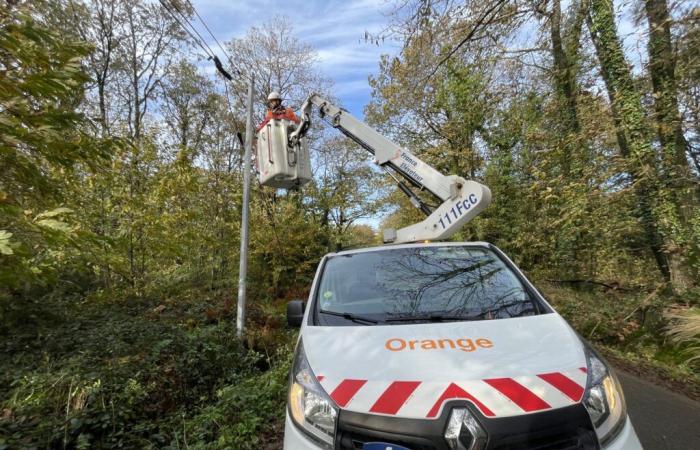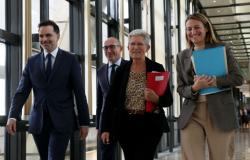
Morbihan
Published on October 28, 2024
Almost a year ago today, storm Ciaran hit Brittany, leaving behind a field of desolation. An extraordinary climatic event. “The most severe that Brittany has experienced since the storm of 1987 with gusts of more than 160 km/h in the north of Morbihan”, underlines Damien De Kerhor, Brittany regional delegate of the operator Orange who takes stock of the this event. Behind the storm the spectacle is disastrous with uprooted trees and destroyed electrical and telephone networks. But it was only the beginning of an equally extraordinary winter. “There were 6 other storms that finally brought down the trees that were still standing after Ciaran. It was in winter that the most strong winds were recorded. We counted 73 days…”, underlines Damien De Kerhor. On the morning of November 2, the results were terrible for the operator Orange: 3,000 poles were broken and had to be replaced, 63,000 customers were deprived of a landline telephone, 116,000 were without a mobile telephone. “The mobile telephone network resisted the wind rather well but it suffers from a lack of electricity,” reports Damien De Kerhor.
An extraordinary challenge
Then begins a project that is also extraordinary for Orange, which had nevertheless anticipated due to the alerts, but… “We have never experienced such a significant outage in Morbihan but also throughout the west of France. We had to increase our pole planting capacity by 8, a real feat! “. Reinforcements from all over France flock to Brittany and work without interruption. In two weeks, 90% of customers regained the network but the last ones had to wait until last summer. “Arteries” (editor's note: hundreds of meters of lines) are destroyed in several places and more than 1000 kilometers of cables – a quarter of which in Morbihan – must be rebuilt even as Orange prepares to stop the copper supply. here 2030… And, another new element, “atypical” to use the terms of Damien De Kerhor, the operator must repair two networks simultaneously: copper and fiber.
Everything is excessive: the extent and severity of the damage, the scale of the project, the supply difficulties since the factories working with copper are reducing their production in view of the imminent cessation of this technology, and we must find in an emergency, thousands of poles… Not to mention the devices necessary to ensure continuity of service such as the distribution of Airboxes (small boxes which allow an internet connection from the mobile network) or data as compensation . “We managed to do all that very quickly…” says Damien De Kerhor.
Lessons from the storm
But this exceptional incident is likely, unfortunately, to happen again. And the operator has sought to learn lessons and several measures have been taken or are being considered.
Orange already has a complex system for carrying out diagnostics, but which has shown its limits. So he will strengthen it so that it can be fully effective in the event of a major crisis. At the same time, it will improve the operating flexibility of its teams and partners with a geographical approach. The other challenge is also to set up an organization that will increase the capacity of teams to carry out checks in the field, which they already do, but here it is a question of deploying the same expertise but on several thousands of kilometers per day.
Storm Ciaran also highlighted the cumbersome administrative procedures which hinder the interventions of technicians. Before they can carry out roadside repairs, for example, they must obtain permits. Work is underway to try to obtain a relaxation of these rules during periods of major crisis.
Pruning: a necessary citizen awareness
Over the years, the operator notices that the pruning work is less and less well done and that more and more bank plants are left abandoned and develop anarchically above the cables. “It’s a real subject of citizen awareness. It is very important to maintain the hedges, to prune the hedges regularly, to plant trees that are adapted to these constraints,” insists Damien De Kerhor.
The scourge of cable theft
Cable thefts are increasing at a rate that is becoming problematic. Since January 1 of this year, around fifty thefts have been recorded in Morbihan, peaking in the spring. 17 kilometers of cables were stolen, which mobilized technicians and generated significant disruptions, which users suffered. A phenomenon that even the mobilization of the police cannot stop. However, Damien De Kerhor suggests that new strategies are being put in place which could seriously complicate the lives of thieves…
Innovations for the benefit of victims of cuts
In all these crisis situations, there are users who find themselves without a telephone from one day to the next. And especially those who have no other means of communication than the good old landline telephone. They are not numerous but still represent 3 to 4% of the population, especially in rural areas. “We lent very easy-to-use mobile phones but we noticed that these users were unable to use them…” notes Damien De Kerhor.
So researchers came up with another ingenious solution that could solve this problem. “We developed a small box which was put into service a few weeks ago which connects to the satellite network. The customer can connect their traditional telephone to this box and therefore not be disturbed in their daily habits. »
But that's not all. In order to be able to re-establish a temporary network even in areas where everything has been destroyed, Orange has designed “Safety cases”, i.e. blocks of variable size powered by battery and therefore autonomous and which are connected to the satellite. They thus make it possible to recreate “a wifi bubble” which notably makes it possible to restore means of communication to the rescue teams.





